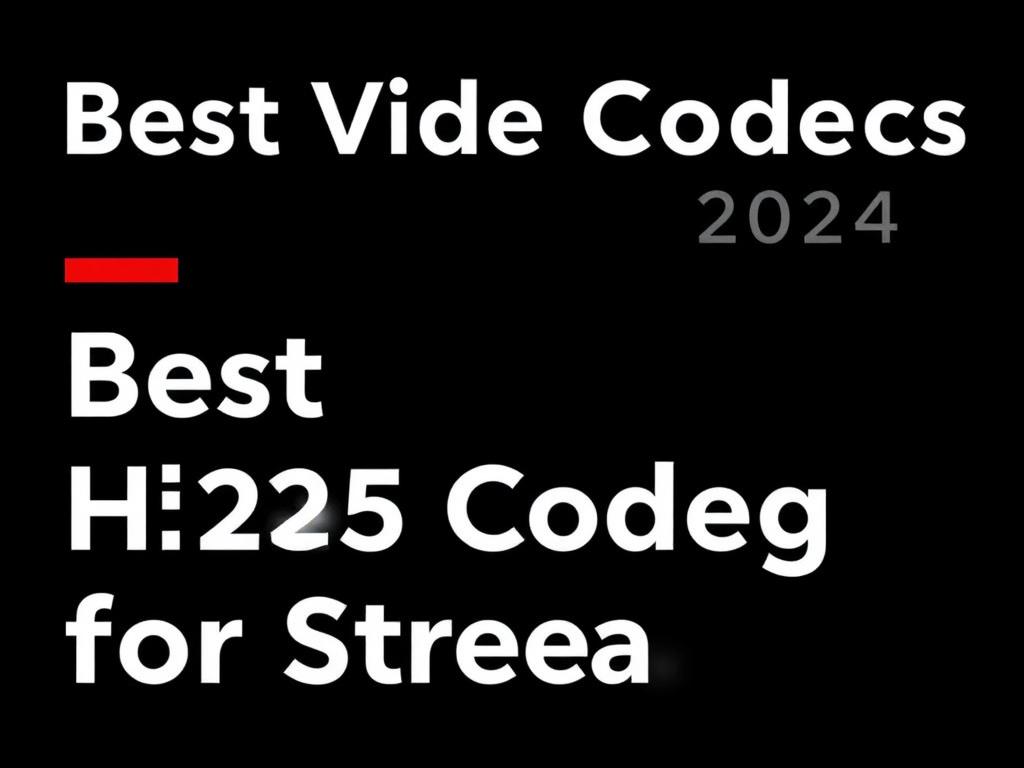Streaming videos seamlessly in 2024 demands more than just a fast internet connection; it hinges importantly on the choice of the right video codec. Whether you’re a content creator, video platform, or simply a tech enthusiast, understanding video codecs and their impact on streaming quality and efficiency is crucial. A video codec compresses and decompresses digital video, making it possible to transmit large video files over networks without enormous bandwidth needs while still maintaining quality. As streaming platforms compete to deliver crystal-clear content with minimal buffering, codec technology is advancing rapidly. This article explores the best video codecs for streaming in 2024, breaking down their features, advantages, and the scenarios where they shine.
Understanding Video Codecs: A Quick Primer
Before diving into the specific codecs, let’s understand what a video codec does. The term “codec” comes from “coder-decoder” or “compressor-decompressor.” Essentially, a codec compresses the large raw video data into a smaller size for efficient streaming and then decompresses it on the viewer’s device for playback. This encoding and decoding process is vital because uncompressed video requires huge amounts of storage and bandwidth, making online streaming impractical for the average internet user.
There are two major types of codecs: lossy and lossless. Lossy codecs reduce file size by discarding some information, sometimes leading to quality loss, but allowing real-time streaming with lower bandwidth. Lossless codecs preserve all the original quality but produce much larger files, which are less suited for streaming. The focus here is mainly on lossy video codecs optimized for streaming.
Top Video Codecs for Streaming in 2024
The streaming industry constantly evolves with new codecs designed to improve compression efficiency, reduce latency, and support higher resolutions like 4K and beyond. Here are the leading video codecs that dominate streaming in 2024:
1. H.264 (AVC) – The Tried and Tested Workhorse
H.264 has been the gold standard for years. It offers a great balance of compression efficiency and compatibility, making it the default codec for streaming on most platforms. While newer codecs have surpassed it in compression capability, its widespread hardware and software support guarantees smooth playback across devices from smartphones to smart TVs.
Advantages include:
- Excellent compatibility with almost all devices
- Good compression for standard HD and Full HD streaming
- Low computational demand, which is great for less powerful devices
However, H.264’s main drawback today is that it requires more bandwidth compared to newer codecs to maintain comparable visual quality.
2. H.265 (HEVC) – The Next-Gen Compression Champion

High-Efficiency Video Coding, or H.265, is the successor to H.264 and offers around 50% better compression. This means you can stream higher-quality video with half the data. HEVC is particularly useful for 4K and 8K streaming where bandwidth savings become essential.
However, H.265’s adoption has been somewhat slowed by licensing costs and variable device compatibility. Still, in 2024, it remains a go-to codec for many streaming services focusing on premium content.
Features of H.265:
- Significantly better compression than H.264
- Ideal for Ultra HD and HDR content
- Supports advanced tools like tiles and slices for error resilience
3. AV1 – The Open-Source Disruptor
Developed by the Alliance for Open Media, AV1 is a game-changer in the world of streaming codecs. It offers compression efficiency comparable or better than H.265 but without the restrictive licensing fees. For streaming platforms aiming to reduce costs and stay future-proof, AV1 adoption has grown tremendously.
AV1’s strengths include:
- Royalty-free licensing, making it attractive to developers
- Excellent compression at both low and high bitrates
- Designed specifically for internet video streaming, with robust error tolerance
Despite these advantages, AV1 requires more computational power to encode and decode, which can impact older or less capable devices. However, advancements in hardware decoding support have made it increasingly accessible.
4. VP9 – Google’s Popular Streaming Codec

VP9, created by Google, gained popularity as YouTube’s preferred codec after H.264. It offers about 30% better compression than H.264, making it an efficient choice for high-quality streaming without blowing up bandwidth usage.
Important points about VP9:
- Open-source and royalty-free
- Good wide device support, particularly on Android and Chrome browsers
- Efficient compression at high resolutions including 4K
Though AV1 is slowly superseding VP9, many platforms still rely on VP9 due to its balance of compatibility and modern performance.
5. Emerging Codec: VVC (H.266)
Versatile Video Coding, or VVC (also known as H.266), is the latest codec in line and promises to double the compression efficiency of H.265. Though it’s still in early stages of adoption, 2024 sees growing interest in VVC for next-gen streaming, especially as 8K content becomes more mainstream.
VVC highlights:
- Superior compression capabilities at all resolutions
- Advanced support for immersive video formats (e.g., 360-degree VR)
- Currently limited hardware and software support, but expanding
| Codec | Compression Efficiency | Licensing | Device Support | Ideal Use Case |
|——–|———————–|———–|—————–|——————————–|
| H.264 | Moderate | Licensed | Universal | Standard HD Streaming |
| H.265 | High | Licensed | Good | 4K, HDR Premium Streaming |
| AV1 | Very High | Royalty-Free | Growing | Cost-effective 4K & HDR Streaming|
| VP9 | High | Royalty-Free | Broad | YouTube and Android streaming |
| VVC | Very High (upcoming) | Licensed | Emerging | Future 8K and immersive content |
Choosing the Right Codec for Your Streaming Needs
Selecting the perfect codec depends on several important factors. Here’s a checklist to help you decide which codec might work best for your situation:
- Target Audience Devices: What hardware do your viewers use? If they rely on older devices, H.264 or VP9 may ensure smoother playback.
- Bandwidth Constraints: If you want to deliver the highest quality at lower bitrates, consider AV1 or H.265.
- Content Type and Resolution: HEVC and AV1 handle HDR and Ultra HD content better, while H.264 is adequate for standard HD.
- Licensing and Costs: If budget is a concern, open-source royalty-free codecs like AV1 and VP9 are appealing.
- Encoding and Decoding Performance: Think about your encoding infrastructure and user device capabilities since AV1 and VVC can be more demanding.
The Future of Streaming Codecs: What Comes Next?
The streaming landscape in 2024 is exciting with innovative codecs emerging continually. AV1’s rise shows a big move toward royalty-free, highly efficient codecs, reducing long-term costs for streaming operators. Meanwhile, VVC promises to revolutionize ultra-high-resolution streaming as hardware uptake accelerates. Additionally, research into AI-powered codecs and perceptual optimization could further enhance video quality while shrinking file sizes.
Streaming platforms are increasingly adopting adaptive streaming protocols alongside these codecs. Technologies like DASH and HLS dynamically adjust video quality based on real-time bandwidth, leveraging codec efficiency to reduce buffering and improve user experience. With increasing demands for 4K, 8K, VR, and interactive video formats, the codec ecosystem will continue evolving swiftly.
Conclusion

Choosing the best video codec for streaming in 2024 largely depends on balancing quality, device compatibility, bandwidth, and cost. While H.264 remains a reliable standard for broad compatibility, newer codecs like H.265 and AV1 deliver superior compression, making them ideal for high-resolution streaming and bandwidth-constrained environments. VP9 holds its place due to its open-source nature and solid performance, especially in YouTube-centric workflows. Meanwhile, emerging technologies like VVC promise to redefine streaming as content resolutions and immersive experiences push higher. Ultimately, understanding the strengths and trade-offs of each codec empowers streamers and content providers to deliver the best possible video experience to their audience in today’s rapidly evolving streaming world.